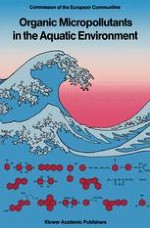1988 | OriginalPaper | Buchkapitel
Influence of Waste Water Disinfection Treatments on Some Genotoxic Chemical Micropollutants
verfasst von : A. Savino, R. Pasquini, R. Conti, C. Melchiorri, A. Di Caro, L. Sebastiani, A. Grella, S. Bonacci
Erschienen in: Organic Micropollutants in the Aquatic Environment
Verlag: Springer Netherlands
Enthalten in: Professional Book Archive
Aktivieren Sie unsere intelligente Suche, um passende Fachinhalte oder Patente zu finden.
Wählen Sie Textabschnitte aus um mit Künstlicher Intelligenz passenden Patente zu finden. powered by
Markieren Sie Textabschnitte, um KI-gestützt weitere passende Inhalte zu finden. powered by
This study compares the effects of different waste water treatments using sodium hypochlorite, chlorine dioxide and ozone on some chemical and biological parameters. The samples studied were obtained from an activated sludge treatment plant of the urban effluents of a large city and from a mixed urban and industrial waste sewage (treated only by sedimentation). A bacterial mutagenicity test (Ames test), microbiological examinations (coliforms, fecal streptococci and coliphages), determinations of the principal chemical parameters and of some organic micropollutants (polycyclic aromatic hydrocarbons - PAH -, and volatile haloderivatives - VHO -) were carried out on the effluents both before and after disinfection. The results showed that all treated and untreated samples were not mutagenic and that only ozone was able to reduce the concentration of all the examined organic micropollutants. Treatment with hypochlorite decreased only PAH concentration, even though their halogenated derivatives and trihalomethanes were formed. Trihalomethanes were found generally in lower concentrations after disinfections with chlorine dioxide. Hypochlorite showed a good bactericidal activity, but a little viricidal activity, whereas chlorine dioxide and ozone had a very good disinfectant activity both on bacterial and viral forms.
